Related Research Articles

Peel is a seaside town and small fishing port in the Isle of Man, in the historic parish of German but administered separately. Peel is the third largest town in the island after Douglas and Ramsey but the fourth largest settlement, as Onchan has the second largest population but is classified as a village.

The Isle of Man Railway (IMR) is a narrow gauge steam-operated railway connecting Douglas with Castletown and Port Erin in the Isle of Man. The line is 3 ft narrow gauge and 15+1⁄2 miles long. It is the remainder of what was a much larger network that also served the western town of Peel, the northern town of Ramsey and the mining village of Foxdale. Now in government ownership, it uses original rolling stock and locomotives and there are few concessions to modernity.
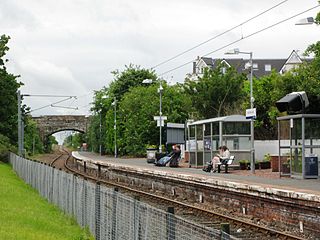
North Berwick railway station is a railway station serving the seaside town of North Berwick in East Lothian, Scotland. It is the terminus of the Edinburgh to North Berwick Line, 22+1⁄4 miles (35.8 km) east of Edinburgh Waverley.
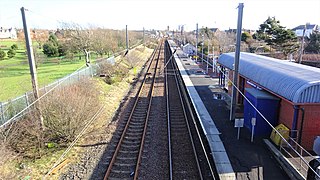
Ardrossan South Beach railway station is one of three in the town of Ardrossan, North Ayrshire, Scotland. The station is managed by ScotRail and is on the Ayrshire Coast Line.

Ardrossan Town railway station is one of three remaining in the town of Ardrossan, North Ayrshire, Scotland. It is one of the oldest operational railway stations in Ayrshire, although services and facilities are severely cut back from the station's peak in the early 20th century. The station is currently managed by ScotRail and is on the Ayrshire Coast Line.
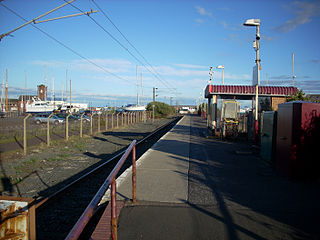
Ardrossan Harbour railway station is one of three remaining railway stations in the town of Ardrossan, North Ayrshire, Scotland. The station is managed by ScotRail but unusually it is not owned by Network Rail, but instead owned by Peel Ports. It is on the Ayrshire Coast Line, 32.5 miles (52.3 km) south west of Glasgow Central. The station is an interchange for Caledonian MacBrayne ferry sailings to Brodick on the Isle of Arran.

Douglas Railway Station is the main terminus of the Isle of Man Railway and is located at the landward end of the quay in Douglas, the capital of the Isle of Man. It was once the hub for now closed lines to Peel, Ramsey and Foxdale.
The Manx Northern Railway (MNR) was the second common carrier railway built in the Isle of Man. It was a steam railway between St John's and Ramsey. It operated as an independent concern only from 1879 to 1905.

The Isle of Man Railway Museum in the village of Port Erin in the Isle of Man is a small museum of the history of the Isle of Man Railway from its founding in 1873 to the present, including the now-closed lines that served Peel, Ramsey and Foxdale, and the remaining open line between Douglas and Port Erin.
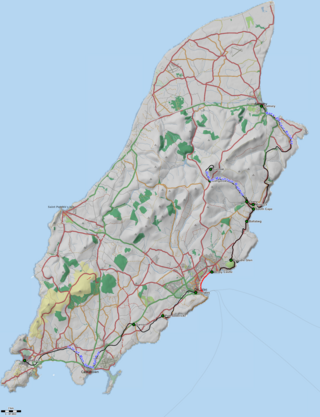
The Isle of Man has a rich transport heritage and boasts the largest narrow-gauge railway network in the British Isles with several historic railways and tramways still in operation. These operate largely to what is known as "Manx Standard Gauge" and together they comprise about 65 miles (105 km) of Victorian railways and tramways. The Isle of Man Railway Museum in Port Erin allows people to find out more about the history of the Manx railways, and was until 1998 accompanied by a similar museum in Ramsey, which was dedicated to the history of the electric line, but this was closed and converted into a youth club. The steam railway to the south of the island, electric to the north and mountain line to the summit of Snaefell, the island's only mountain, are all government-owned, and operated under the title Isle of Man Railways, as a division of the island's Department of Infrastructure. The lines at Groudle Glen and Curraghs Wildlife Park are both privately owned but open to the public.
The Foxdale Railway was a 3 ft narrow gauge branch line which ran from St. John's to Foxdale in the Isle of Man. The line ran 2+1⁄4 miles (3.6 km) from an end-on junction with the Manx Northern Railway west of St. John's, then passed to the north of the Isle of Man Railway station before curving south and crossing the IMR's line from Douglas via an overbridge to the east of the station. The line had a fairly constant incline through Waterfall(s) Halt, the only intermediate station, to the terminus in Upper Foxdale. The tracks extended beyond Foxdale into the mine workings area.
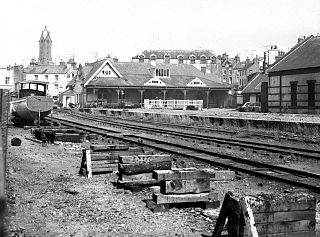
Peel Railway Station was a terminus on the Isle of Man Railway; it served the town of Peel in the Isle of Man and was the final stopping place on a line that ran between the city of Douglas and the town. It was part of the Island's first railway line.

St John's Railway Station was on the Isle of Man Railway (IMR), later merging with the nearby station of the Manx Northern Railway (MNR); it was the junction of lines to Douglas, Peel, Ramsey and Foxdale. It was close to Tynwald Hill. The station began life in 1873 as the penultimate stop on the Peel Line, the island's first passenger railway line; it consisted of a simple wooden waiting shelter with accommodation for the station master, and a passing loop. This layout remained until the arrival of the new line from the north in 1879 when a second station was established, later merging with the existing one. The station was the hub of the island's railway network, where the lines to Douglas, Peel, Ramsey and Foxdale met.

Ramsey Station was a station on the Manx Northern Railway, later owned and operated by the Isle of Man Railway; it served the town of Ramsey in the Isle of Man, and was the terminus of a line that ran between St. John's and this station, which was the railway's headquarters. The station opened to traffic on 23 September 1879.
One of the characteristics of the Isle of Man Railway is the numerous level crossings and farm crossings along the various routes; many smaller crossing places are marked only by gates that criss-cross farm land and provide access to private roads connecting the farms to the main roads. Being largely rural in nature the railway has many of these scattered along the existing South Line, and there were many more on the closed sections of the railway. These can be summarised as follows, along with other points of interest along the line not covered in the Isle of Man Railway stations section:-
Kenton was a railway station on the Mid-Suffolk Light Railway. The station was located a mile north of the hamlet of Kenton.

George Kenner was a German artist. He made 110 paintings and drawings during the First World War while interned as a German civilian internee in Great Britain and the Isle of Man.
West Auckland railway station served the villages of St Helen Auckland and West Auckland in County Durham, England, between 1833 and 1962. It was on the railway line between Bishop Auckland and Barnard Castle. There was a locomotive depot, which was the only one to be both closed completely and later reopened by the London and North Eastern Railway.
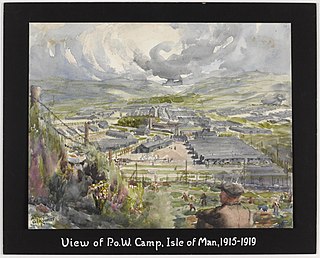
Knockaloe Internment Camp was a WWI internment camp on the Isle of Man, at Knockaloe Farm in the parish of Patrick, near Peel, which housed 23,000 prisoners-of-war and 3,000 guards between 1914 and 1919. It was served by the Knockaloe railway station and branch line.

The Portsmouth and Ryde Joint Railway was a group of three railway lines in Southern England that were jointly owned and operated by the London and South Western Railway and the London, Brighton and South Coast Railway. The main line was between Cosham and Portsmouth Harbour; there was a branch from Fratton to East Southsea; and a line between Ryde Pier Head and Ryde St John's Road. The last-named section was isolated from the others, being on the Isle of Wight. The first section of line opened in 1847 and the last in 1885; the Southsea branch closed in 1914 but all of the other routes have since been electrified and remain open.
References
- Notes
- Bibliography
- Butt, R.V.J. (1995), The Directory of Railway Stations, Patrick Stephens, ISBN 1-85260-508-1